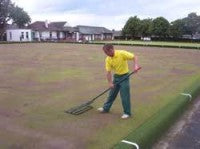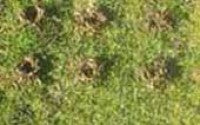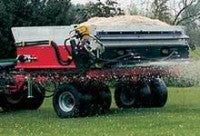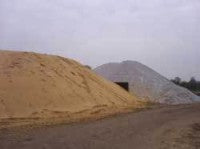Basic principles of top dressing
Basic principles of top dressing
By Alan Penn NPFA

Top dressing is one of the most vital maintenance operations undertaken by groundstaff, and should be carried out annually, especially on fine turf surfaces. There are two types of top dressing suitable for application to sports surfaces: either 'origin based' (the same as the soil on the site), or sand based. Each of these dressings is applied for a different purpose.
The origin/organic-based top dressing is applied to improve soil nutrients that have been removed during mowing. This type will also aid surface levels. The sand-based dressing helps soil drainage, especially on wet winter pitches.
A professional soil analysis (NPK & pH) of the existing topsoil and proposed top dressing should always be carried out before any application is made. This is normally undertaken by a professional organisation or company who will sample the soil to establish its current condition.
The top dressing should be compatible with the soil in place and will normally consist of a mixture of loam, sand, and organic matter. Any top dressing should be obtained from a reputable source and specifically for sports turf.
If the top dressing is of poor quality it may change the pH and affect grass growth generally. It may also contain pests, diseases and weeds. A representative sample should be obtained for analysis before an order is placed.
Selecting an appropriate top dressing
The following factors must be considered when choosing a top dressing material:
1 The sport to be played on the surface. For example, applications of light material to a cricket square will destroy the binding properties of the surface.
2 The standard required and how much use is likely. Any top dressings applied during the autumn will determine the standard and the wear the surface will tolerate
3 Professional advice should be sought on the properties of the existing soil and the type of grass sward present.
4 All top dressing should be obtained from a reputable supplier and prepared especially for sports surfaces. It should be sterile and free from pests, diseases and weeds.
5 pH level should be checked to determine the compatibility with the soil already present.
It is essential that top dressings from year to year should be consistent. The most suitable material should be decided from the beginning for the site and the same material used every year. It is not a good idea to experiment using one material then another in an attempt to improve results. Variations in top dressing materials could result in the creation of layered soil profiles, impeded root growth, root breaks and inconsistent sports surfaces.
When and where to use top dressings
Top dressing is normally applied in the autumn when renovations are taking place but if necessary it may be applied lightly throughout the playing season to aid surface levels and aid sward growth.
Applications should not be made when the surface or the top dressing are wet. It is almost impossible to spread in such conditions because the grass sward may be smothered by being prevented from growing through the top dressing.
Applications should not therefore be applied as autumn turns to winter. The grass will not grow during the dormant period of winter and will be smothered by the top dressing.
The weather should be suitable before considering an application in the spring, and the dressing should be applied only lightly and incorporated well into the surface.
Hand-applied dressings are usually made on fine turf surfaces such as bowling greens and cricket tables, although larger areas may be mechanically top dressed. A sandy top dressing may be applied to goalmouth areas during the playing season to aid surface water drainage. Sand may also be applied to the whole pitch to keep drainage sand slits open.
Before applying top dressing in the autumn, scarification and aeration operations are normally undertaken to remove any unwanted growth or thatch from the surface. Depending on the type of aeration chosen this may aid the incorporation of the top soil into the surface.
The purpose of scarification is to remove all thatch and unwanted growth. The pitches can be scarified using tractor-mounted equipment. This will remove thatch from the surface. If the area is relatively small scarification can be undertaken using a spring-bok rake or motorised hand scarifier.
The type of aeration to be considered depends on the maintenance programme.



There are three types:
1.Solid tine producing a small round hole in the turf.
2.Slit tine producing a narrow cut in the turf almost like a knife.
3.Hollow tine producing a core of soil which is left on the surface and must be removed. Top-dressing is then applied to the green and used to fill the holes left by the hollow tines.
Benefits of applying top dressing
Mixes will differ from pitch to pitch depending on what the soil already contains. The benefits of applying top dressings include:
-
The creation of level surfaces as the top dressing is worked into the ground.
-
An increase in the organic matter in the soil which may also improve the soil structure.
-
Control of moss. Evidence has shown that moss is encouraged by poor aeration and starved soil conditions.
-
Fertilisers incorporated in top dressing will help to return nutrients removed from the surface during mowing.
Good, even surface levels cannot be guaranteed if a fine turf bowls green or cricket pitch is not regularly top dressed. Any attempt to cut costs by dressing only selected parts of the surface will merely result in the loss of an even playing surface especially if no dressing is applied over a number of years.
Applying top dressing
The method of application will depend on the size of the area and the amount to be applied.
Hand applications consist of broadcasting the material with a shovel and working the top dressing well into the surface using a lute or brush. When making the application by hand it is recommended that the area be divided up with string to apply the dressing as evenly as possible.

Whichever method is used applications should be even and the groundstaff must work any top dressing well into the surface. They should not place a fresh soil on the surface as this will subsequently create a distinct layer as the grass grows through it. The recommended method for incorporating top dressing into the surface is either by using a lute or drag brush on fine turf areas and a drag mat for larger areas.
Top dressing materials
Loam
The type of loam used in top dressing will depend on the existing soils. Sites which contain large amounts of clay may require the application of light sandy loams. This will obviously depend on what the surface is to be used for, for example light sandy loams are unsuitable for cricket wickets.

The popularity of sand stems from its large particle size. This aids aeration in heavy soils and also assists surface drainage in conditions of heavy wear. Sand can be obtained from many sources, but care should always be taken to ensure that it is washed, calcium free and of the particular grade required.
Organic material
The acidity of peat will depend on where and how it was formed. Peat when used in top dressing has the advantage of increasing the water-holding capabilities of soil.
The materials mentioned are the main constituents of top dressings, but whatever materials are used it is essential that they are non-toxic to plant growth and do not contain pests, diseases or weeds.
Recommendations
A range of commercial top dressing materials are currently available and if the best results are to be achieved it is of particular importance to choose the most appropriate material for particular sports, especially on fine turf surfaces.
NPFA
The National Playing Fields Association, a registered charity, is the only national organisation which has specific responsibility for acquiring, protecting and improving playing fields, playgrounds and playspace in the United Kingdom. The NPFA holds legal responsibility for over 1,000 such sites, covering over 8,000 acres (3,250 hectares) of recreational land across the UK.
It also promotes sports, games, recreation and play among all sections of the community and, as appropriate, among people of all age groups. It has developed considerable expertise in the preparation and development of facilities for a wide range of competitive and recreational sports and activities. This guidance gives advice on top dressing natural turf.
Further information on NPFA products and services
The National Playing Fields Association produces a wide range of technical publications which provide guidance on many aspects of play and sports facilities. A full list of current publications is available from the Products and Services Sales Team:
Telephone: 020 7833 5360 Email: npfa.sales@npfa.co.uk or follow the link at http: www.playing-fields.com
The information contained in this publication originated from many sources and no responsibility can be accepted or liability undertaken by the NPFA, for any error or omission, or for any losses or damages arising there from - whether direct or indirect. In particular, the NPFA accepts no responsibility for, and gives no express or implied warranty or other assurance in relation to the accuracy or completeness of any information contained in this publication.
